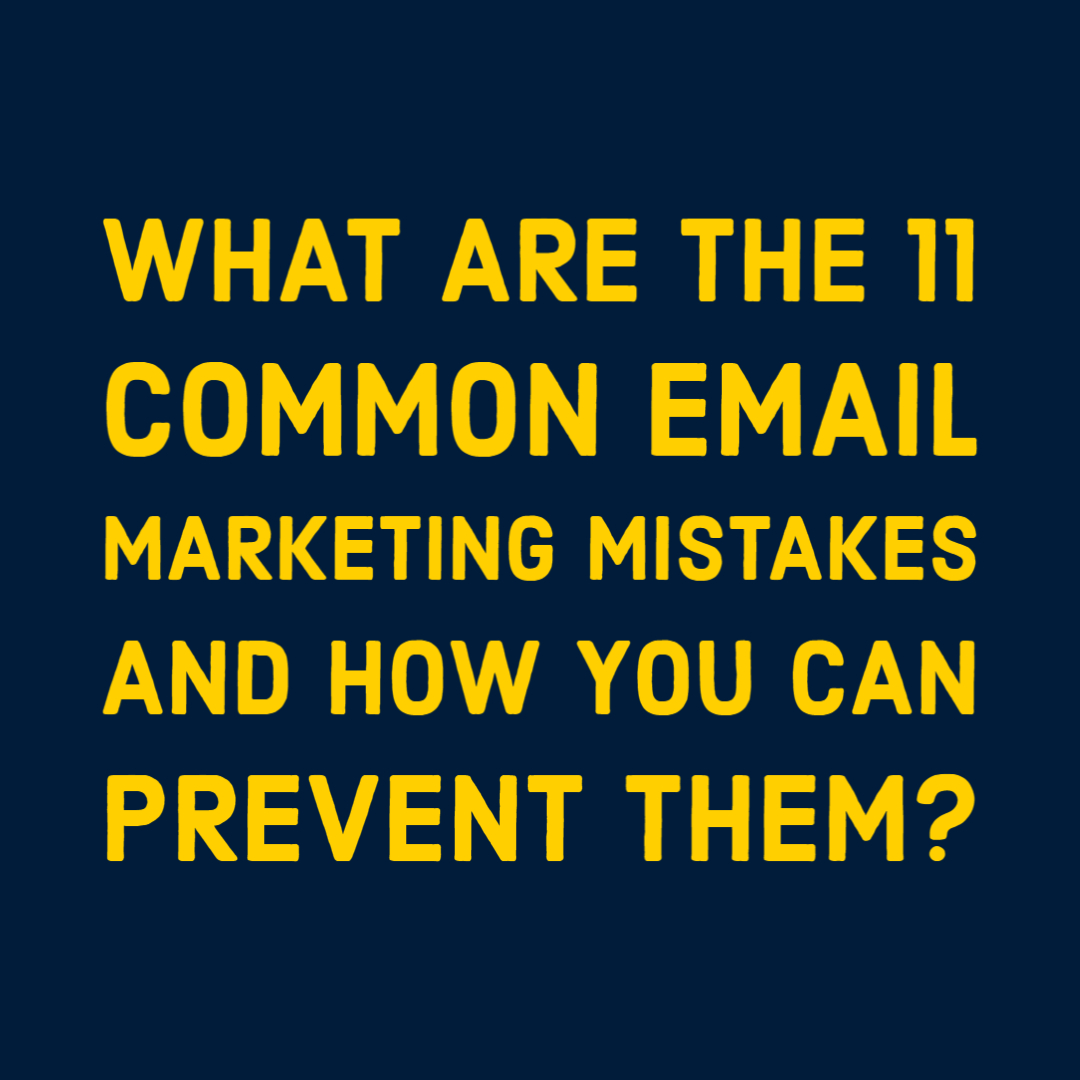What Are The 11 Common Email Marketing Mistakes And How You Can Prevent Them? #digitalmarketing #digitalmarketer

Among other available options, Marketing through emails is the best strategy. With email marketing, you can entice your customers to come back and keep your brand name evergreen in their minds.
If your email marketing campaigns do not yield positive results even after repeated attempts, it means that you may be doing it the wrong way.
Often times, advertisers are confronted with the questions listed below:
- What could be the reason why my subscribers are not opening the email?
- Why is the rate of unsubscribers relatively high?
- Does it mean that they didn’t like the content after opening it?
The most important step to solving your problem is identifying your mistakes, and once you are able to tackle it, you are sure to derive positive results within the near future.
We will discuss some common mistakes made when sending marketing emails in this article and how you can correct them.
Here are common email marketing mistakes email marketers make and how to avoid them
1.The use of inferior subject lines
Are you aware that more than 47% of email recipients open an email simply based on the subject line alone? You will find out that many of your received emails never get opened if you check your inboxes.
Don’t be surprised to hear that about 69% of email recipients also report emails as spam just because of the subject line. Most marketers are yet to realize that hyped-up subject lines are the major reasons why recipients report marketing emails as spam.
Despite the fact that readers avoid labeling their regular senders as spam, nevertheless, promising them the impossible can still prompt them to click the delete button.
When creating a subject line, here are some important points to note:
- You should personalize it.
- You should avoid yelling at the readers by using all capital letters.
- You should keep the subject line professional.
- You should avoid fluff words.
- You should keep it crisp and simple.
2. Not sending a welcome email
Let us say for instance, a new subscriber who was scrolling through your website comes to terms with the value of information shared in your email newsletters and decided to sign up.You are making a huge mistake if you were planning to immediately send them regular newsletters after they sign up.
Welcome emails unlike regular marketing emails, have the highest open rates and gives you the opportunity to connect with your customers. If you are still searching for the essence of welcome emails immediately after signup, here it is. In fact, the revenue you generate through welcome emails is 320% more than regular marketing messages. Moreover, unlike other email, these emails have a massive click rate of 196% and 336% transaction rate.
3. Overloading subscriber’s inbox with lots of emails
According to research, an average individual receives about 121 emails daily, if you multiply this number by 365, it is 44,165 emails in a year!
Taking a good look at this huge number of emails hitting an individual’s inbox every year, you can’t help but understand why users tend to eventually unsubscribe from email newsletters. The reason is quite simple, they just don’t have enough time to go through all the messages.
Therefore, you should note that if you are one of the email marketers sending too many emails to your customers, the chances of them hitting the unsubscribe button are very real. Customers are supposed to be happy to receive your message, after all that is the reason they signed up for your email list in the first place.
Do not forget they signed up as a result of the contents you provide, so, do not disappoint them by using all your emails as sales pitches or sending numerous emails. Another way to tackle this issue is that during the signup, you can give your subscribers the opportunity to inform you about their preferences and the frequency at which they desire to receive your emails.
4. Not allowing your subscribers reply
Another common mistakes made by marketers is attaching the “do not reply” messages. There is no subscriber that will love to receive an email from an organization that they won't be able to reply them.
You have to make sure that you send your newsletters through an email that permits the reader to communicate back to you. You can get it done through another means such as adding a reply back button that guides the readers to a landing page dedicated to posting any questions, comments or suggestions that they wish to communicate.
5. Paying minimal attention to mobile readers
According to research, more than 77% of Americans use their smartphones for checking their emails, this alone is a proof that you need to design your email messages in such a way that will be suitable for desktop viewers.
Imagine a poorly optimized email message for mobile devices, this might not go down well with a potential customer.
You know what this means, they either unsubscribe or quit opening the messages in the future. In order to avoid this, you must take adequate care to make sure that your email messages are mobile-friendly by all means.
We understand that there are certain things that as a marketer you may not have control over such as poor network quality or older devices, but you can prepare layouts that permits most of your readers to view the content more appropriately.
6. Sending emails at an improper time

Truthfully, there are no particular rules regarding the best time to send an email, this to a great extent depends on your brand and audience. Just ensure that you send your emails at a time when your target audience will read the email. Nevertheless, the best time for you to send an email is
between 9:00 and 11:00 AM.
We suggest this time because office hours begin during this time, and people are most likely to check their emails as their first task.
Carefully, answer the following questions because they will assist you in deciding the best time to send an email.
- First question is who are your audiences?
- Second question is where do they live?
- Third question is what do they do for a living?
- Fourth question is what are their pain points?
- Fifth question is how can you solve their problems?
One thing you have to make sure of when sending emails to your customers is, making sure that it serves their purpose. You have to state your intentions clearly when sending an email. You must by all means avoid sending simply Simply a “hello” email, because it doesn't add any value to their life.
Therefore, it is necessary that you include a call to action button. But while at it, do take note of the following:
- Do ensure that you do not litter your email with several Call To Action buttons in your inbox.
- Make sure it is bold enough to attract the reader's attention.
- Make sure that the action can be taken within a few clicks.
8. Inability to segment your subscribers
People are different, so are your subscribers. They vary greatly in their tastes and preferences, so if you have plans of sending a single email to all your subscribers, you are a step away from failing. For instance, the interest of a 25-year-old female subscriber will be different from a male subscriber in his fifties.
For you to attain the height of a successful email marketer, you must not neglect category segmentation, because it is an important component for success in an email marketing campaign.
What segmenting your email list does is that it helps you send emails that are relevant to your subscribers. A way to achieve this is by segmenting your list based on your subscriber's unique preferences, like:
- Their age
- Their location
- Their geographical details
- Their sales cycle
- Their interests
- Their language
- History of their previous purchase etc.
9. Failure of tracking the campaign
How do you know whether your present marketing strategy is working according to the plan or not? It is simple, by checking the response rate.
You should integrate your email marketing campaigns with tracking software to find out the effectiveness and figure out which messages instigatem customers to take the right action.
The essence of the tracking system is to assist you in enhancing your marketing strategy and your conversion rate.
10. Neglecting GDPR considerations
In late May 2018, the GDPR laws came into place, and have entirely changed the email marketing world. Adhering to the GDPR, businesses must provide proof that customers have opted to receive marketing emails, nevertheless, these rules are not applicable to those who reside in US, but those who live in Europe. If you follow the GDPR guidelines, at least you will be able to reap the benefits of your marketing campaigns within the umbrella of law.
11. Overcrowding your email
Here is another most common mistakes marketers make in their campaigns. Email marketers tend to overcrowd their emails with lots of deals, product information, and announcements in a bid to avoid sending too many emails.
We understand the reason behind this mistake – to ensure the maximum sharing of information through fewer emails, but do not forget that this can leave a negative impression on the mind of the reader. Readers these days prefer emails that stick to one major point in the content with the message talking about the subject line directly.
In conclusion, it is no longer news that email marketing has proven to be one of the most preferred and effective means of marketing. But unfortunately, most marketers go about it using the wrong approach. Once the mistake is detected, it is easy to correct it, but the problem lies in your ability to detect it. You have to pay a closer attention to why you are not getting enough conversion rates, or why your subscribers are opting out.
Nevertheless, employ the use of the tips we have given to you to improve your marketing campaign and increase customer retention.